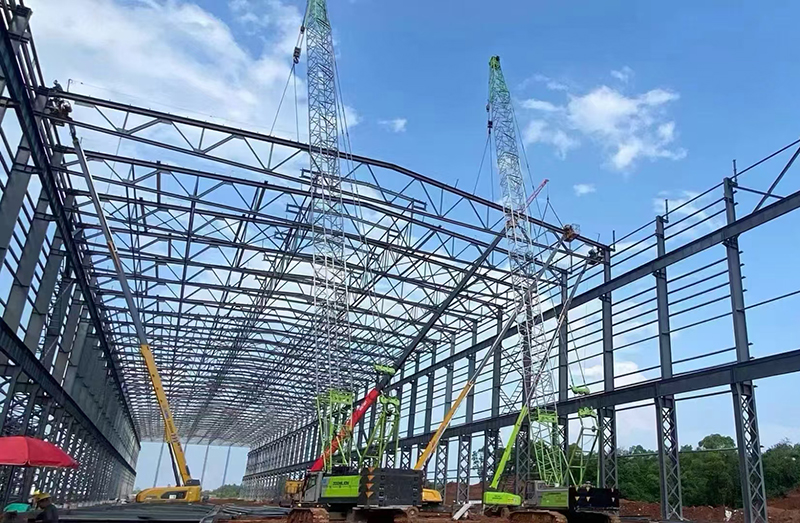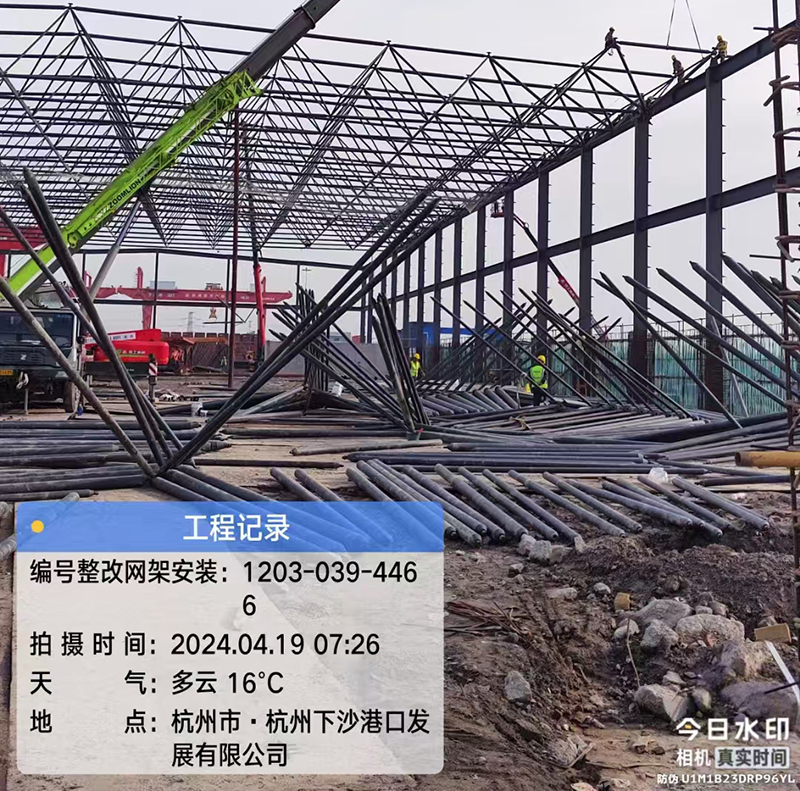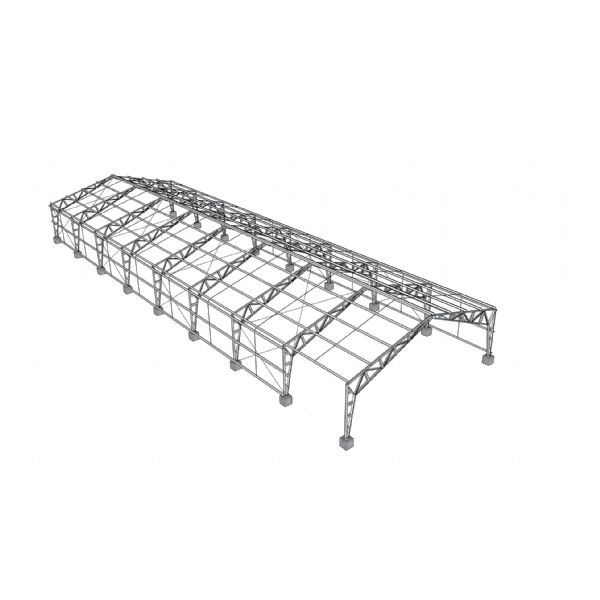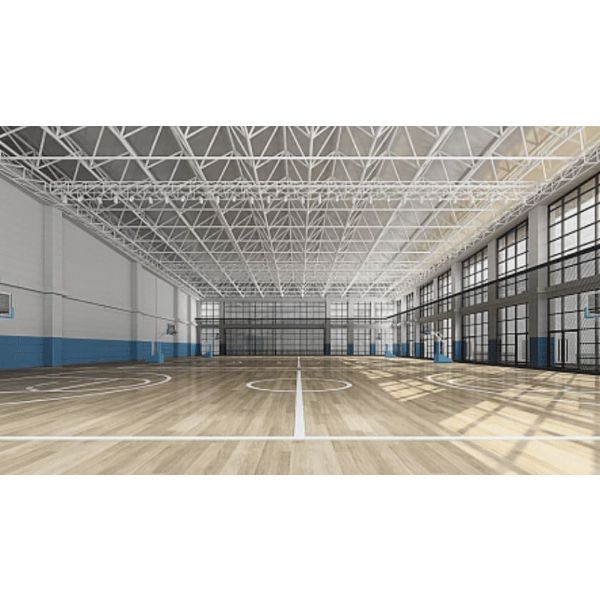Steel Structure Warehouse Project Details
Located in Hangzhou, the Zhejiang Qiantang River Water Conservancy Steel Structure Warehouse represents a modern achievement in sustainable energy infrastructure. Completed in 2024, this project was designed with a strong emphasis on efficiency, durability, and structural precision. With a total building area of 8,100㎡ and a steel usage of 750 tons, the facility integrates advanced engineering methods with practical functionality. ItsSteel Structure Warehouse relies on a standard portal frame system, ensuring stability while accommodating the heavy mechanical and operational requirements of a large-scale energy facility.
Strategic Location in Hangzhou
The project’s location in Hangzhou is both symbolic and functional. Situated along the Qiantang River, the facility plays a vital role in supporting the region’s water conservancy efforts while contributing to local energy supply. The integration of the Steel Structure Warehouse with river management infrastructure highlights the importance of balancing energy generation with environmental responsibility. By leveraging the strategic position, the plant not only serves industrial needs but also strengthens Hangzhou’s role as a hub for modern energy development in Zhejiang Province.
Building Scale and Area
Covering a total area of 8,100㎡, theSteel Structure Warehouse was carefully designed to optimize both space and functionality. Every aspect of the layout, from the positioning of heavy machinery to the allocation of service zones, was guided by operational efficiency. The plant accommodates large equipment while maintaining accessibility for maintenance and upgrades, ensuring long-term adaptability. The building area also reflects the balance between compact design and the need to host complex operational systems typical of large power plant structures.
Use of Steel and Structural Advantages
One of the defining features of this project is the extensive use of steel in its construction. With a total steel usage of 750 tons, the facility benefits from the inherent durability, load-bearing strength, and flexibility that steel structures provide. The choice of a Steel Structure Warehouse built with steel ensures resilience against both natural elements and operational stresses. Steel not only supports the heavy machinery inside but also provides a long service life with reduced maintenance compared to other materials.
Standard Portal Frame Design
The structure relies on a standard portal frame, a proven model in industrial construction. This type of design is particularly well-suited for wide-span buildings, offering an unobstructed interior that maximizes operational space. For a Warehouse, this is critical, as it allows for seamless integration of turbines, generators, and other large-scale equipment without structural interference. The portal frame also supports rapid construction timelines, cost efficiency, and flexibility in future modifications or expansions.
Completion and Significance in 2024
The successful completion of the project in 2024 marks a pivotal milestone for Zhejiang’s water conservancy and energy infrastructure development. This achievement represents years of careful planning, engineering innovation, and coordinated effort, ultimately delivering a facility that strengthens both regional stability and long-term sustainability.
From an energy perspective, the power plant significantly enhances Zhejiang’s energy security. By integrating renewable generation with advanced grid systems, it helps meet the growing electricity demands of urban and industrial users while reducing reliance on external energy sources. The plant’s operational efficiency also contributes to lower carbon emissions, supporting China’s national goals for clean energy transition.
In the field of water conservancy, the project has far-reaching implications. It provides crucial support for flood control, irrigation, and ecological balance within the Qiantang River basin. By aligning energy production with water resource management, the facility safeguards communities, ensures agricultural productivity, and preserves aquatic ecosystems—all within a single integrated framework.
Equally important is the project’s role as a symbol of modernization. As one of the latest additions to China’s expanding portfolio of multipurpose infrastructure, the plant embodies the country’s ability to merge traditional functions of water management with state-of-the-art industrial architecture. Its design and performance establish a new benchmark for projects that must balance engineering durability, environmental stewardship, and social benefit.
Ultimately, the completion of this facility in 2024 is not just the delivery of another Steel Structure Warehouse—it is the creation of a strategic hub of energy and water management. It demonstrates how infrastructure in the 21st century can evolve from serving single purposes to addressing multiple interconnected challenges, positioning Zhejiang as a leader in integrated regional development.
Role in Energy and Water Conservancy
Beyond its primary function as an energy-generating facility, this Steel Structure Warehouse plays a strategic dual role within the larger Qiantang River Water Conservancy project. Its design and operation go far beyond supplying electricity; it also integrates seamlessly into regional water resource management systems.
One of its critical contributions is flood control. By regulating water flow through advanced storage and discharge mechanisms, the plant helps reduce the risk of flooding during heavy rainfall and seasonal water surges. This protective measure safeguards nearby cities, agricultural lands, and infrastructure, ensuring both economic and social stability in the region.
The facility also plays a vital role in irrigation support. Controlled water releases from the plant feed into downstream irrigation channels, enabling consistent agricultural production across vast farmlands. This reliable water supply ensures that farmers can maintain crop yields even during dry seasons, thereby strengthening local food security.
In addition, the plant contributes significantly to environmental sustainability. By carefully balancing energy generation with ecological water flow requirements, it helps maintain healthy aquatic ecosystems along the Qiantang River. This approach preserves biodiversity, improves water quality, and supports fisheries that are essential for community livelihoods.
The multifunctional role of this plant reflects a broader trend in modern infrastructure planning, where single facilities are engineered to deliver multiple benefits. In this case, the integration of energy production, flood management, irrigation, and environmental conservation demonstrates how innovative design can serve both community well-being and industrial growth within one comprehensive framework.
Long-Term Value
The Zhejiang Qiantang River Water Conservancy Power Plant reflects a vision of long-term growth. With its durable steel construction, efficient portal frame design, and strategic location, the facility is expected to provide reliable service for decades. Its design prioritizes safety, energy efficiency, and adaptability, making it a model for future projects in the region and beyond.
The completion of the Zhejiang Qiantang River Water Conservancy power plant in 2024 underscores the importance of combining engineering expertise with environmental responsibility. With its 8,100㎡ building area, 750 tons of steel usage, and standard portal frame design, the project highlights the strength of modern Steel Structure Warehouse. Positioned in Hangzhou, the facility is not only a contributor to the region’s energy needs but also a symbol of sustainable infrastructure development in Zhejiang Province.






